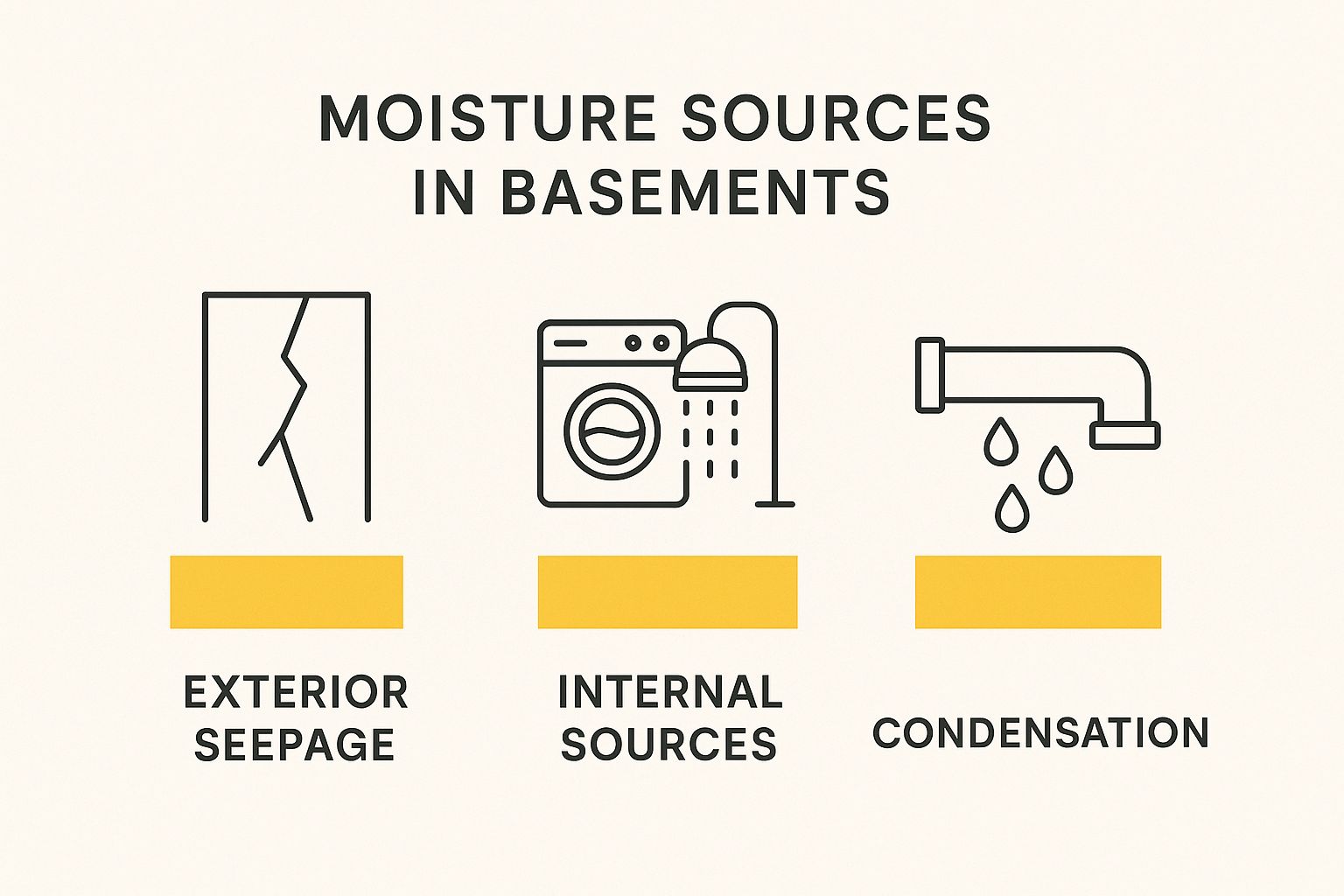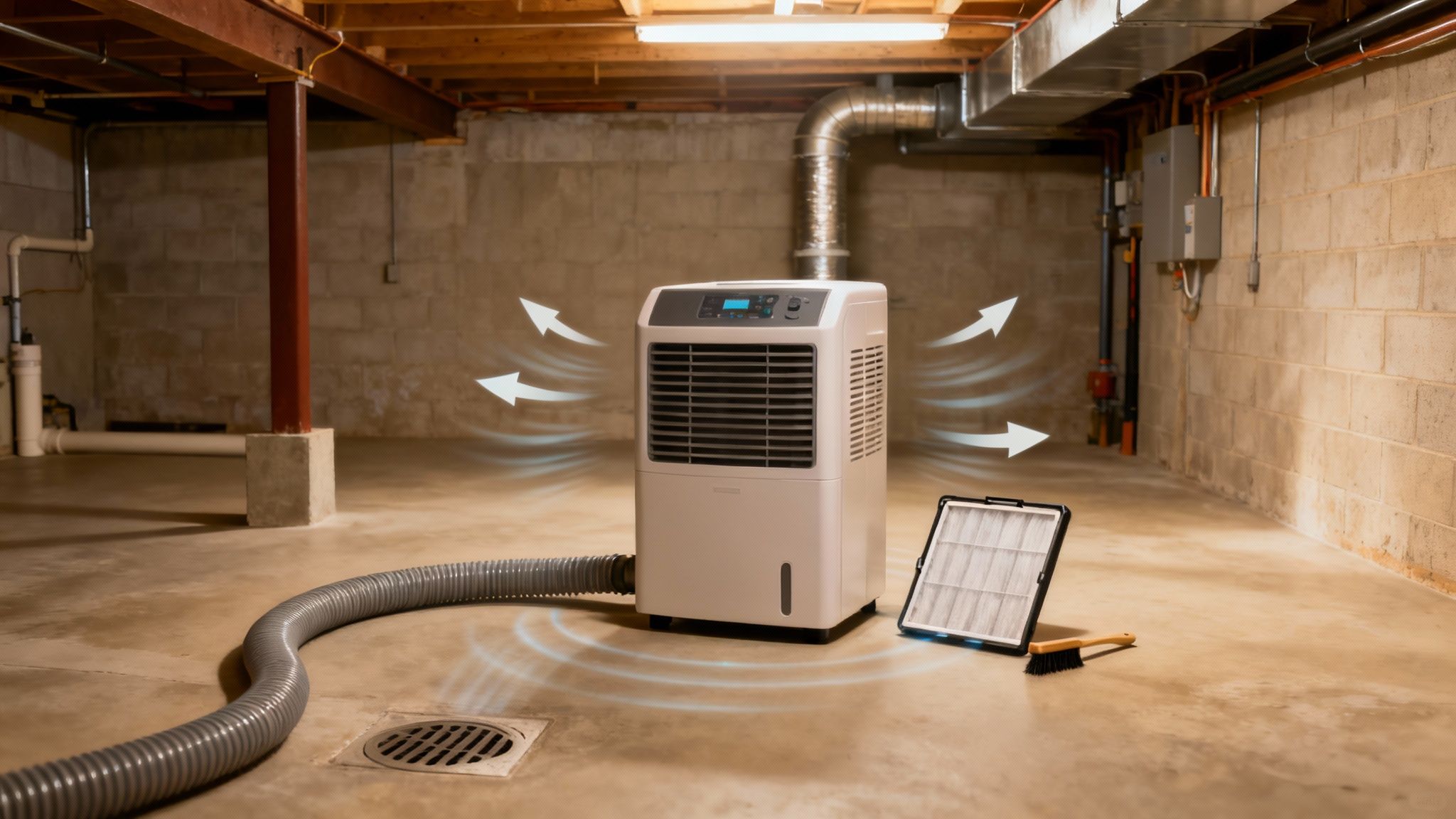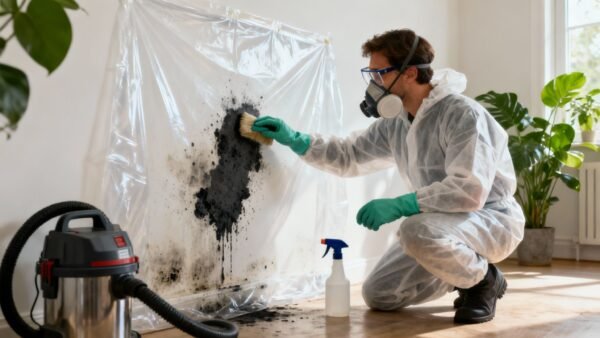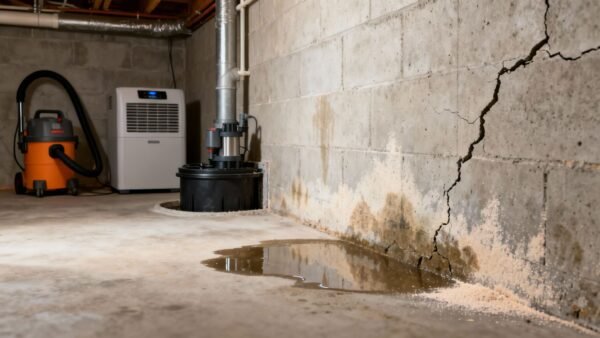That damp, musty smell drifting up from your basement isn’t just unpleasant—it’s a clear warning sign of excess moisture. Effective basement dehumidification is the solution, but it’s far more than a quick fix for a bad smell. It’s a crucial step in protecting your home’s structural integrity, improving indoor air quality, and preventing costly mold problems. For homeowners in Southern California, where coastal fog and unexpected leaks can create hidden dampness, managing basement humidity is especially important.
Properly controlling basement moisture is the first line of defense against issues that can impact your entire home. Let’s explore why your basement gets damp and how to fix it for good.
If you suspect a serious moisture problem, don’t wait.
Schedule a Free Moisture Assessment
Why Basements Get Damp and Musty
Think of your basement as a giant, cool sponge buried in the ground. It’s surrounded by moist soil, and since concrete is porous, it naturally pulls that moisture inward through a process called capillary action. This is a constant battle, especially after heavy rains or in areas with high groundwater tables.
Combine that with poor air circulation, and you have a recipe for that classic clammy feeling. Warm, humid air from upstairs sinks into the cool basement, where it condenses on cold concrete walls, pipes, and floors. All this excess moisture creates that distinct musty odor, a tell-tale sign of mold or mildew. While some homeowners might try DIY solutions, learning how to get rid of mold naturally is often just a temporary fix for a deeper problem.
The Consequences of Unchecked Basement Humidity
Once relative humidity levels stay above 50%, your basement becomes an ideal breeding ground for serious problems. This isn’t just a comfort issue; it’s a direct threat to your home and health.
- Mold and Mildew Growth: These fungi thrive in damp, dark spaces, releasing spores that can trigger allergies, asthma, and other respiratory issues. A musty smell in a Sherman Oaks home is often the first sign of a hidden mold colony.
- Dust Mite Infestations: Like mold, these microscopic pests flourish in high humidity, worsening allergy and asthma symptoms for residents.
- Structural Damage: Persistent moisture is incredibly destructive. It can rot wooden support beams, warp flooring, damage stored belongings, and even compromise your home’s foundation over time.
Catching the early signs of water damage is the best way to stop these issues before they escalate. Proactive basement dehumidification is your best defense for keeping the space below your home healthy, safe, and stable.
How to Identify the Source of Basement Moisture
Effective basement dehumidification starts with playing detective. Before you invest in a powerful machine, you must determine why your basement is damp. Treating the symptom (dampness) without diagnosing the root cause is a waste of time and money.
Moisture in a basement almost always comes from one of three sources. Pinpointing which one is affecting your home is the critical first step.

As you can see, moisture can seep in from outside, be generated inside, or form from condensation. Each requires a different strategy.
The Three Culprits of Basement Dampness
- Exterior Water Intrusion: This is the classic leaky basement, where water pushes its way in from the outside. Look for damp spots on walls after rain, water stains near the floor, or a chalky white powder on concrete called efflorescence. These are signs that groundwater is entering through cracks or porous concrete. A serious leak, like one from a cracked foundation in a hillside Calabasas home, might require professional structural drying techniques for homeowners.
- Internal Moisture Sources: Everyday activities can generate a surprising amount of humidity. Unvented clothes dryers, long hot showers, or even cooking can release gallons of water vapor into your home’s air, which naturally settles in the basement. If your basement feels extra humid after doing laundry, this is likely a contributing factor.
- Condensation: This occurs when warm, moist air contacts a cold surface. You’ll see this as “sweating” or water droplets on cold water pipes, HVAC ducts, or concrete walls. It’s especially common during humid months when the temperature difference between the outside air and your cool basement surfaces is greatest—a frequent occurrence in coastal areas like Santa Monica.
Pinpointing the source is non-negotiable. A high-end dehumidifier won’t solve a foundation leak, and sealing cracks won’t stop condensation from an unvented dryer. A clear diagnosis leads to an effective solution.
The growing demand for basement dehumidifiers shows that more homeowners are taking this seriously. The global market is already estimated at $2.5 billion, driven by worries over mold and the health issues that come with damp environments.
Get a Free Moisture Inspection
How to Choose the Right Dehumidifier for Your Basement
Once you’ve identified the moisture source, it’s time to select the right tool for the job. Choosing a dehumidifier is the most critical step in winning the battle against basement dampness.
The two main types are refrigerant and desiccant models, and they work in completely different ways.
A refrigerant (or compressor-based) dehumidifier functions like a small air conditioner. It draws in damp air and passes it over chilled coils. The moisture condenses into water, which drips into a collection bucket or drain. The machine then exhausts drier, slightly warmer air back into the room. This is the workhorse for most basements, especially where temperatures remain mild.
A desiccant dehumidifier uses a special absorbent material to pull water from the air. Air flows through a rotating wheel coated in this desiccant, which sponges the moisture out. This technology excels in colder spaces where refrigerant models would struggle or freeze.
Key Factors in Your Decision
Choosing the right unit comes down to three things: your basement’s conditions, your budget, and your tolerance for maintenance.
- Capacity (Pints Per Day): This is the most important metric. It indicates how many pints of water the unit can remove from the air in 24 hours. For a typical 1,500-square-foot basement with moderate dampness, a 50-pint model is a good starting point. For very damp or larger spaces, consider a 70-pint unit or larger.
- Energy Efficiency: A dehumidifier can run for many hours a day, so energy consumption matters. Always look for an ENERGY STAR®-certified model. These units use about 15% less energy than non-certified counterparts, saving you money on your utility bills over time.
- Drainage Options: You have two choices: manual or continuous. Emptying a bucket daily is tedious. A model with a port for a gravity drain hose is good, but one with a built-in condensate pump is best. It offers true set-it-and-forget-it convenience by automatically pumping the collected water up and out to a nearby sink or drain.
Comparing Dehumidifier Types
To make the choice crystal clear, here’s a head-to-head comparison.
Basement Dehumidifier Comparison: Refrigerant vs. Desiccant
| Feature | Refrigerant (Compressor) Dehumidifier | Desiccant Dehumidifier |
|---|---|---|
| Best For | Standard basements (50°F and above) with moderate to high humidity. | Cold basements, garages, or crawl spaces (below 50°F). |
| Pros | More energy-efficient in warmer temps, widely available, lower initial cost. | Performs consistently in low temps, quieter operation, lighter weight. |
| Cons | Less effective in cold conditions, can be noisy, heavier units. | Less energy-efficient in warmer temps, higher purchase price. |
For most Southern California homes, a refrigerant model is the most effective and affordable choice. However, for unheated basements or garages that get chilly, a desiccant unit might be the better long-term solution.
Best Practices for Dehumidifier Placement and Maintenance

Owning a dehumidifier isn’t enough; you need smart placement and regular upkeep to achieve the best results. A little strategy goes a long way in your basement dehumidification efforts.
Place your dehumidifier in a central location, away from walls and large furniture. This allows for optimal 360-degree airflow, enabling it to pull in damp air from all corners and circulate dry air effectively.
Proper placement is a non-negotiable first step. A high-capacity unit tucked in a corner will struggle to control humidity across the entire basement, wasting energy and delivering poor results.
Creating a Low-Maintenance System
To avoid the chore of emptying a heavy water bucket, set up a continuous drain. Most modern dehumidifiers have a port to attach a standard garden hose.
- Gravity Drain: The simplest option is to run the hose from the unit to a nearby floor drain. Ensure the hose has a consistent downward slope for gravity to do the work.
- Condensate Pump: If you lack a floor drain or need to drain water upward to a utility sink, a model with an integrated condensate pump is the ideal solution.
Your Monthly Maintenance Checklist
Consistent maintenance ensures efficiency and a long lifespan for your unit. For more in-depth strategies on keeping your basement dry, check out our professional mold removal tips.
Follow this simple routine:
- Clean the Filter (Monthly): A clogged filter restricts airflow, forcing the unit to work harder. Most filters can be rinsed with warm water. Let it dry completely before reinstalling.
- Check the Coils (Quarterly): Dust can build up on the evaporator coils, reducing their efficiency. A gentle cleaning with a soft brush or vacuum attachment will keep them clear.
- Inspect the Drain Hose (Quarterly): Ensure the drain hose isn’t kinked or clogged, as a blockage can cause water to back up and overflow.
Setting the Ideal Basement Humidity Level
Achieving the right humidity level is a science. The target “sweet spot” for a healthy basement is a relative humidity (RH) between 30% and 50%.
When RH climbs above 50%, you’re creating a welcoming environment for mold, mildew, and dust mites. This is the threshold where indoor air quality begins to suffer. If you suspect mold is already present, learning how to know if it’s mold is your critical next step.
Conversely, letting humidity drop below 30% can cause its own problems. Overly dry air can damage wood furniture, flooring, and structural elements, making them brittle and prone to cracking.
Maintaining the Perfect Balance
The easiest way to monitor humidity is with a hygrometer, a simple digital tool that provides a real-time RH reading.
Most modern dehumidifiers include a built-in humidistat, which is even better. You can set your target humidity (e.g., 45%), and the machine will automatically cycle on and off to maintain that level, saving energy and providing perfect climate control.
This need for precise humidity control is a significant driver in the home appliance market. In North America, the dehumidifier market has surpassed a $1.1 billion valuation, largely due to increased awareness of indoor air quality and the rise of smart home technology. You can find more details in the global dehumidifier market report from futuremarketinsights.com.
Frequently Asked Questions About Basement Dehumidification
Here are answers to the most common questions we receive from homeowners about basement dehumidification.
Q: How much does it cost to run a basement dehumidifier?
A: The cost depends on the unit’s size, its Energy Star rating, your local electricity rates, and how often it runs. For a modern 50-pint Energy Star model, you can expect to spend between $30 and $70 per month. To minimize costs, choose an appropriately sized, high-efficiency model and seal any air leaks in your basement.
Q: Can I use a small room dehumidifier in my basement?
A: This is not recommended. Basements are large, high-humidity environments that require a high-capacity unit (at least 50 pints) to be effective. A small dehumidifier will run constantly, increase your energy bills, wear out quickly, and fail to control the humidity adequately.
Q: Will a dehumidifier get rid of musty smells?
A: Yes, it addresses the root cause. That “dank basement” smell is caused by mold and mildew, which require moisture to grow. By reducing humidity below the 50% threshold, a dehumidifier eliminates the conditions these fungi need to survive, effectively neutralizing the source of the odor. For more on this, see our mold remediation FAQ.
Q: When should I call a professional for basement moisture?
A: A dehumidifier is a powerful tool, but it can’t solve everything. It’s time to call a professional restoration company if you observe any of the following:
- Standing water or recurring puddles.
- Visible mold growth on walls, floors, or ceilings.
- A persistently damp basement despite running a dehumidifier continuously.
These are signs of a larger issue, like a foundation leak or hydrostatic pressure, that requires expert diagnosis and repair.
It’s also wise to understand your insurance coverage. Review the details on homeowners insurance for water damage and mold before a major problem occurs.
If you’re dealing with stubborn moisture, musty odors, or visible mold that a dehumidifier can’t handle, Onsite Pro Restoration is ready to help. Our IICRC-certified technicians will identify the root cause and implement a professional solution to protect your home and your health.





